Chile’s state lithium push emerges as test for Latam resource nationalism
Statist trend
Chile and neighbors Bolivia and Argentina are believed to hold more than half of the world’s extractable lithium in otherworldly salt flats that typically employ evaporation pools to concentrate the metal, though new technologies are also being developed.
The ruling socialists of Bolivia have also insisted that the state take the driver’s seat in unlocking its huge but untapped reserves, although it is counting on the help of partners like Chinese battery giant CATL to do so.
Peru, a mining powerhouse best known for copper, might have pursued a similar approach to Boric to bolster its development of lithium had former President Pedro Castillo not been ousted late last year.
The leftist Castillo won a narrow victory in 2021, pledging to nationalize the ultra-light metal along with other minerals including copper, but later moderated his position, leaving the promise unfulfilled.
Ivan Merino, who was Castillo’s first energy and mining minister, said in an interview on Monday that Peru is for now watching from the sidelines as the resource nationalism trend gains steam.
“It’s now almost commonplace,” he said. “We will see history made, but without participating in it.”
That leaves the exception to the trend, Argentina, as an increasingly likely Latin American destination for new private capital for lithium.
“That’s not because Argentina is doing what needs to be done, but rather because of our neighborhood’s upheavals and the world’s spiking demand,” said Santiago Dondo, its former deputy minister for mining.
A strong pipeline of lithium projects in Argentina, the world’s No. 4 producer, are already close to coming online.
Dondo said the four political parties in the main opposition coalition to outgoing leftist President Alberto Fernandez recently voted to endorse private enterprise as the sector’s main motor ahead of elections later this year.
He noted that local control over mining in three key provinces in northwest Argentina managed to help thwart any moves toward lithium nationalization at the national level a couple years ago, boosting investor sentiment.
But Dondo still worries that lithium could be eclipsed by another battery technology.
“We don’t know how many years we’ll have this huge window of opportunity,” he said. “Change in the energy transition is getting faster all the time.”
(By David Alire Garcia and Marco Aquino in Lima; Editing by Christian Plumb and Marguerita Choy)
Reuters | April 27, 2023 |

Chile’s President Gabriel Boric. (Image courtesy of Boric’s campaign.)
Chilean President Gabriel Boric’s pitch last week to enshrine greater state control over lithium is emerging as the latest test for the resource nationalism embraced by Latin America’s ascendant left but which has proven tough to implement in practice.

While the former student protest leader’s proposal to give the government a majority stake in all future lithium projects faces an uncertain path in Congress, its mere introduction shook one of the mining industry’s most lucrative corners.
The push from Boric, 37, also highlights the long-running regional tension between governments’ hunger for control of coveted commodities and future profits versus their ongoing need for private sector capital and know-how.
“In Chile, its probably going to be the most significant case,” said Carlos Pascual, top energy executive with IHS Markit, referring to other regional efforts to exert more government control over the mineralseen as key to a greener future and citing Chile’s outsize role in the global metals market as the world’s top producer of copper and No. 2 in lithium.
“This is seen as an opportunity to ensure direct revenues to the state just as many countries decided to make the decision to nationalize oil in a different era,” he added.
Last year, Boric’s fellow leftist in Mexico, President Andres Manuel Lopez Obrador, enacted a sweeping lithium nationalization and later ordered the creation of a new state-run lithium company, LitioMx, even though the country is still far from selling its first cargo of the ultra-light metal.
Lithium is in high demand for rechargeable batteries for future fleets of electric vehicles in the global transition to green energy.
Lopez Obrador, who reveres the country’s landmark 1938 oil nationalization, justified his policy as its logical extension. He invoked past abuses at the hands of colonial masters and more recent corporate titans, arguing that only the government can prevent exploitation and ensure broadly-distributed benefits.
Across the world, nationalizing oil industries in particular has proved attractive as a means of cashing in on valuable raw materials and boosting development, even as competitive commodity markets often see more output and innovation.
Illustrating the challenges of starting from scratch, a Mexican official knowledgeable about government plans for mining, however played down the possibility the new state lithium miner might achieve production anytime soon, instead touting a different option.
“LitioMx could drive the value chain by importing lithium,” the official told Reuters.
Asked for comment, a spokesman for Mexico’s energy ministry stressed that LitioMx remains focused on finding and extracting lithium, and while future imports could be considered “it’s too early for that.”
Unsurprisingly, mining companies are less than ecstatic about the statist tilt of Lopez Obrador and Boric, who stressed that under his plan private miners would be able to partner with a not-yet-created state-owned producer, but only as minority stakeholders.
“It’s a brave bet to ask an investor to prefer an uncertain marriage with a state company and a minority stake risking capital and technology as opposed to simply flying alone,” said Armando Ortega, who chairs the executive committee of Baramin, Mexico’s biggest producer of barite, a mineral used in oil drilling.

Chile’s President Gabriel Boric. (Image courtesy of Boric’s campaign.)
Chilean President Gabriel Boric’s pitch last week to enshrine greater state control over lithium is emerging as the latest test for the resource nationalism embraced by Latin America’s ascendant left but which has proven tough to implement in practice.

While the former student protest leader’s proposal to give the government a majority stake in all future lithium projects faces an uncertain path in Congress, its mere introduction shook one of the mining industry’s most lucrative corners.
The push from Boric, 37, also highlights the long-running regional tension between governments’ hunger for control of coveted commodities and future profits versus their ongoing need for private sector capital and know-how.
“In Chile, its probably going to be the most significant case,” said Carlos Pascual, top energy executive with IHS Markit, referring to other regional efforts to exert more government control over the mineralseen as key to a greener future and citing Chile’s outsize role in the global metals market as the world’s top producer of copper and No. 2 in lithium.
“This is seen as an opportunity to ensure direct revenues to the state just as many countries decided to make the decision to nationalize oil in a different era,” he added.
Last year, Boric’s fellow leftist in Mexico, President Andres Manuel Lopez Obrador, enacted a sweeping lithium nationalization and later ordered the creation of a new state-run lithium company, LitioMx, even though the country is still far from selling its first cargo of the ultra-light metal.
Lithium is in high demand for rechargeable batteries for future fleets of electric vehicles in the global transition to green energy.
Lopez Obrador, who reveres the country’s landmark 1938 oil nationalization, justified his policy as its logical extension. He invoked past abuses at the hands of colonial masters and more recent corporate titans, arguing that only the government can prevent exploitation and ensure broadly-distributed benefits.
Across the world, nationalizing oil industries in particular has proved attractive as a means of cashing in on valuable raw materials and boosting development, even as competitive commodity markets often see more output and innovation.
Illustrating the challenges of starting from scratch, a Mexican official knowledgeable about government plans for mining, however played down the possibility the new state lithium miner might achieve production anytime soon, instead touting a different option.
“LitioMx could drive the value chain by importing lithium,” the official told Reuters.
Asked for comment, a spokesman for Mexico’s energy ministry stressed that LitioMx remains focused on finding and extracting lithium, and while future imports could be considered “it’s too early for that.”
Unsurprisingly, mining companies are less than ecstatic about the statist tilt of Lopez Obrador and Boric, who stressed that under his plan private miners would be able to partner with a not-yet-created state-owned producer, but only as minority stakeholders.
“It’s a brave bet to ask an investor to prefer an uncertain marriage with a state company and a minority stake risking capital and technology as opposed to simply flying alone,” said Armando Ortega, who chairs the executive committee of Baramin, Mexico’s biggest producer of barite, a mineral used in oil drilling.
Statist trend
Chile and neighbors Bolivia and Argentina are believed to hold more than half of the world’s extractable lithium in otherworldly salt flats that typically employ evaporation pools to concentrate the metal, though new technologies are also being developed.
The ruling socialists of Bolivia have also insisted that the state take the driver’s seat in unlocking its huge but untapped reserves, although it is counting on the help of partners like Chinese battery giant CATL to do so.
Peru, a mining powerhouse best known for copper, might have pursued a similar approach to Boric to bolster its development of lithium had former President Pedro Castillo not been ousted late last year.
The leftist Castillo won a narrow victory in 2021, pledging to nationalize the ultra-light metal along with other minerals including copper, but later moderated his position, leaving the promise unfulfilled.
Ivan Merino, who was Castillo’s first energy and mining minister, said in an interview on Monday that Peru is for now watching from the sidelines as the resource nationalism trend gains steam.
“It’s now almost commonplace,” he said. “We will see history made, but without participating in it.”
That leaves the exception to the trend, Argentina, as an increasingly likely Latin American destination for new private capital for lithium.
“That’s not because Argentina is doing what needs to be done, but rather because of our neighborhood’s upheavals and the world’s spiking demand,” said Santiago Dondo, its former deputy minister for mining.
A strong pipeline of lithium projects in Argentina, the world’s No. 4 producer, are already close to coming online.
Dondo said the four political parties in the main opposition coalition to outgoing leftist President Alberto Fernandez recently voted to endorse private enterprise as the sector’s main motor ahead of elections later this year.
He noted that local control over mining in three key provinces in northwest Argentina managed to help thwart any moves toward lithium nationalization at the national level a couple years ago, boosting investor sentiment.
But Dondo still worries that lithium could be eclipsed by another battery technology.
“We don’t know how many years we’ll have this huge window of opportunity,” he said. “Change in the energy transition is getting faster all the time.”
(By David Alire Garcia and Marco Aquino in Lima; Editing by Christian Plumb and Marguerita Choy)
Lithium mining decisions must be in the public interest, Chile economy minister says
Bloomberg News | April 25, 2023 |
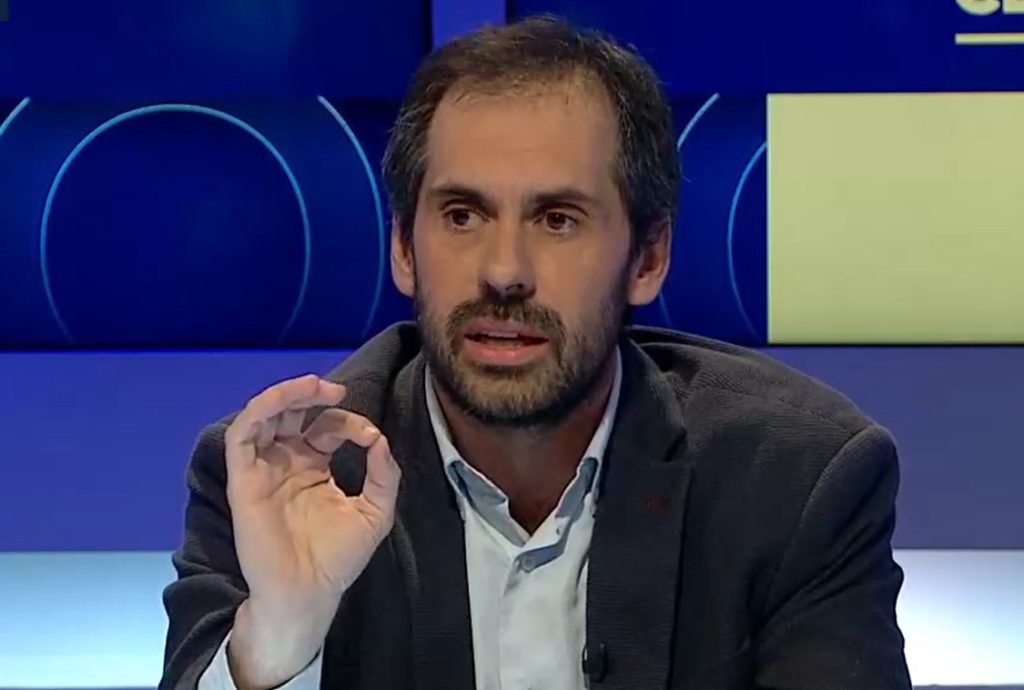
Photo: Nicolás Grau’s Twitter page
Chile’s government gave the clearest sign yet that the state will play an active role in deciding how some of the world’s biggest lithium deposits will be developed in partnership with the private sector.

“The objective is control,” Economy Minister Nicolas Grau said in an interview Tuesday. Control being “that the different fundamental decisions the company makes respond to the interests that we have as a country.”
President Gabriel Boric unveiled a new model last week in which the state will take a controlling stake in future public-private partnerships in the biggest brine deposits. But his administration left state copper giant Codelco in charge of negotiating terms on a case-by-case basis, including with the two incumbent producers, SQM and Albemarle Corp. That left analysts wondering if companies could maintain operational control under the new design.
While negotiations between Codelco and prospective partners will determine the new contracts, at the end of the day, companies’ strategic decisions must be aligned with national interests, Grau said from his office in downtown Santiago.
The government is engaged in a delicate dance of seeking a bigger role for the state while attempting to attract more private capital, defend the environment and move further down the value chain. There’s a lot at stake given Chile has the biggest reserves of a metal that’s critical to the clean-energy transition.
To be sure, the government understands that for the new model to work, the private sector has to be motivated to invest, Grau said. So far, the industry’s reaction has been “rather positive,” he said.
In a statement Monday, SQM, whose contract expires in 2030, said it expects to reach an agreement to continue producing the battery metal under the new model. Albemarle, however, said it would negotiate with Chile closer to the end of its contract in 2043. The two firms can either keep full control of the operation for the rest of the contract and then risk losing it or let the state take a majority stake with the understanding it could keep operating longer.
While Codelco will be the state’s representative in new contracts, in the future that role will be played by a dedicated lithium enterprise. The government plans to present a bill to create a national lithium company later this year, Grau said.
Officials will have to negotiate with lawmakers to secure the bill’s approval, although the administration will propose that the state firm participates in downstream operations such as cathode processing.
“We are going to propose that the national lithium company plays a role in the entire value chain,” Grau said.
(By Matthew Malinowski and James Attwood, with assistance from Eduardo Thomson)
Bloomberg News | April 25, 2023 |

Photo: Nicolás Grau’s Twitter page
Chile’s government gave the clearest sign yet that the state will play an active role in deciding how some of the world’s biggest lithium deposits will be developed in partnership with the private sector.

“The objective is control,” Economy Minister Nicolas Grau said in an interview Tuesday. Control being “that the different fundamental decisions the company makes respond to the interests that we have as a country.”
President Gabriel Boric unveiled a new model last week in which the state will take a controlling stake in future public-private partnerships in the biggest brine deposits. But his administration left state copper giant Codelco in charge of negotiating terms on a case-by-case basis, including with the two incumbent producers, SQM and Albemarle Corp. That left analysts wondering if companies could maintain operational control under the new design.
While negotiations between Codelco and prospective partners will determine the new contracts, at the end of the day, companies’ strategic decisions must be aligned with national interests, Grau said from his office in downtown Santiago.
The government is engaged in a delicate dance of seeking a bigger role for the state while attempting to attract more private capital, defend the environment and move further down the value chain. There’s a lot at stake given Chile has the biggest reserves of a metal that’s critical to the clean-energy transition.
To be sure, the government understands that for the new model to work, the private sector has to be motivated to invest, Grau said. So far, the industry’s reaction has been “rather positive,” he said.
In a statement Monday, SQM, whose contract expires in 2030, said it expects to reach an agreement to continue producing the battery metal under the new model. Albemarle, however, said it would negotiate with Chile closer to the end of its contract in 2043. The two firms can either keep full control of the operation for the rest of the contract and then risk losing it or let the state take a majority stake with the understanding it could keep operating longer.
While Codelco will be the state’s representative in new contracts, in the future that role will be played by a dedicated lithium enterprise. The government plans to present a bill to create a national lithium company later this year, Grau said.
Officials will have to negotiate with lawmakers to secure the bill’s approval, although the administration will propose that the state firm participates in downstream operations such as cathode processing.
“We are going to propose that the national lithium company plays a role in the entire value chain,” Grau said.
(By Matthew Malinowski and James Attwood, with assistance from Eduardo Thomson)
Column: Chile uses an old copper template for new lithium plan
Reuters | April 25, 2023 |
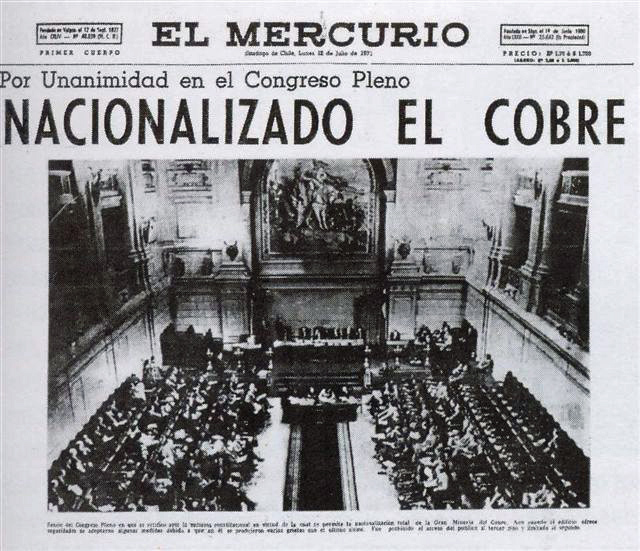
Chilenización del cobre – 11 July 1971. Image: Codelco
Chile’s assertion of state control over its lithium industry has sent shock waves through the new energy metals sector.

The country’s two big lithium producers, SQM and Albemarle, have seen their share prices fall on the prospect of having to relinquish majority control of their operations or risk losing their licences once they expire in 2030 and 2043 respectively.
Shares in companies such as Pilbara Minerals, Australia’s biggest lithium producer, have risen on the premise of slower investment and project growth in Chile, which hosts the world’s largest deposits of the battery metal.
Chile has been here before.
The country nationalized its copper sector in 1971, provoking international outrage, particularly in the United States.
President Gabriel Boric’s lithium “nationalization” is a more benign version, using an even earlier copper model.
Moreover, Chile is far from the only country seeking to channel the new energy metals boom.
The copper model – good and bad
If President Boric’s lithium policy is an echo of past copper policy, the comparison is with the “Chileanization” program of the Eduardo Frei Montalva administration in the late 1960s.
Frei embarked on a creeping nationalization, buying 51% stakes in existing copper mines and projects and wrapping them into the Copper Office, renamed in 1966 as the Corporacion Nacional de Cobre (Codelco).
All the US companies that then controlled Chile’s copper production negotiated a reduction of their holdings. Kennecott Copper led the way, selling in 1967 a 51% stake in the El Teniente mine with the proceeds reinvested in an expansion program.
The “win-win” state-private balancing act was upset in 1971 when President Salvador Allende won Chilean elections on a platform of speeding up the process.
The hard nationalization that followed saw US copper companies stripped of their shares for minimal compensation after the government offset book value with previous “excess profits”.
There was legal blowback, including court seizures of physical copper cargoes, and economic and political blowback from the United States.
Lithium play
Codelco is still owned by the Chilean government and now the world’s largest copper producer.
Even the neo-liberals of the Augusto Pinochet regime kept the national jewel in the crown as they opened the rest of the country’s’ copper sector up to the private sector.
Indeed, it was only in 2019 that Chile formally revoked the law requiring 10% of Codelco’s export sales be directed to the military, although technocrats had long since replaced generals on the company’s board.
It is now Codelco that is tasked with taking control of the country’s lithium sector.
There is no need for expropriation since the Chilean state owns the country’s reserves. Rather, there will be a “negotiated nationalization” similar to that of the copper industry in the 1960s.
Talks with SQM will start almost immediately, according to Economy Minister Nicolas Grau. SQM said that it needs an additional $2 billion to meet the new lithium plan’s sustainability goals, an echo of Kennecott’s sale-for-investment copper deal of 1967.
Others, particularly smaller operators at the exploration stage, may welcome the prospect of state support.
CleanTech Lithium, which is working on direct extraction rather than brine evaporation in Chile, noted the new policy was one of “partnership rather than nationalization” and “may offer the potential for further opportunity”.
Given the Chilean government’s interest in steering its industry towards more sustainable lithium extraction, state participation could turn out to be enabler rather than a dead weight for such companies.
Everything, of course, depends on how the policy is executed.
Join the club
Chile is not alone in seeking to assert control of its mineral resources as the world gears up for a new metals age.
Mexico nationalized its lithium deposits last year and in February this year handed over responsibility for developing them to the country’s energy ministry.
Zimbabwe has banned the export of unprocessed lithium, citing the need to constrain illegal artisan mining.
The shining example for others is Indonesia, which has used export controls to force its nickel miners downstream.
Exports of ore were banned from 2020, leading operators to build first nickel pig iron smelters and more recently processing plants capable of producing nickel in battery-friendly form.
The EU last year won a World Trade Organization (WTO) panel ruling that Indonesia’s ban on exports was a breach of WTO trade rules.
Indonesia has forged ahead anyway and now boasts the world’s largest nickel production sector, which it is rapidly leveraging into a global battery-materials hub.
Breaking the free-market rules has proved to be a massive accelerator for Indonesia, showing that state intervention doesn’t always come at the price of slower industrial progress.
It’s not just producer countries that are using government muscle to shape metal supply chains.
Such is the scramble for all sorts of critical minerals that governments in consuming countries are stepping in as well.
Japan’s Ministry of Economy, Trade and Industry will subsidize half the cost of smelting and mine development projects of important minerals including lithium by Japanese companies, according to Nikkei Asia.
The European Union is actively seeking what it terms “mutually beneficial partnerships” with emerging producers as part of its critical raw materials policy.
The United States, desperate to reduce reliance on China, is pumping money into its mining and metals sector and hasn’t shied away from state participation either.
The US Defense Department is a direct investor in both the light and heavy rare earth processing facilities being constructed in partnership with Australia’s Mynas Corp.
Chile isn’t an outlier when it comes to the new energy metals age, it’s part of a growing club of nations.
(The opinions expressed here are those of the author, Andy Home, a columnist for Reuters.)
(Editing by Emelia Sithole-Matarise)
Reuters | April 25, 2023 |

Chilenización del cobre – 11 July 1971. Image: Codelco
Chile’s assertion of state control over its lithium industry has sent shock waves through the new energy metals sector.

The country’s two big lithium producers, SQM and Albemarle, have seen their share prices fall on the prospect of having to relinquish majority control of their operations or risk losing their licences once they expire in 2030 and 2043 respectively.
Shares in companies such as Pilbara Minerals, Australia’s biggest lithium producer, have risen on the premise of slower investment and project growth in Chile, which hosts the world’s largest deposits of the battery metal.
Chile has been here before.
The country nationalized its copper sector in 1971, provoking international outrage, particularly in the United States.
President Gabriel Boric’s lithium “nationalization” is a more benign version, using an even earlier copper model.
Moreover, Chile is far from the only country seeking to channel the new energy metals boom.
The copper model – good and bad
If President Boric’s lithium policy is an echo of past copper policy, the comparison is with the “Chileanization” program of the Eduardo Frei Montalva administration in the late 1960s.
Frei embarked on a creeping nationalization, buying 51% stakes in existing copper mines and projects and wrapping them into the Copper Office, renamed in 1966 as the Corporacion Nacional de Cobre (Codelco).
All the US companies that then controlled Chile’s copper production negotiated a reduction of their holdings. Kennecott Copper led the way, selling in 1967 a 51% stake in the El Teniente mine with the proceeds reinvested in an expansion program.
The “win-win” state-private balancing act was upset in 1971 when President Salvador Allende won Chilean elections on a platform of speeding up the process.
The hard nationalization that followed saw US copper companies stripped of their shares for minimal compensation after the government offset book value with previous “excess profits”.
There was legal blowback, including court seizures of physical copper cargoes, and economic and political blowback from the United States.
LEADING TO THE CIA AND HENRY KISSINGER OVERTHROWING THE SOCIALIST GOVERNMENT OF SALVADORE ALLENDE IN 1973
Chile’s copper grab was part of a broader trend of developing countries taking state control of their mineral riches. Zambia, the world’s second largest copper producer at the time, did exactly the same three years later in 1974.
Chile’s copper grab was part of a broader trend of developing countries taking state control of their mineral riches. Zambia, the world’s second largest copper producer at the time, did exactly the same three years later in 1974.
Lithium play
Codelco is still owned by the Chilean government and now the world’s largest copper producer.
Even the neo-liberals of the Augusto Pinochet regime kept the national jewel in the crown as they opened the rest of the country’s’ copper sector up to the private sector.
Indeed, it was only in 2019 that Chile formally revoked the law requiring 10% of Codelco’s export sales be directed to the military, although technocrats had long since replaced generals on the company’s board.
It is now Codelco that is tasked with taking control of the country’s lithium sector.
There is no need for expropriation since the Chilean state owns the country’s reserves. Rather, there will be a “negotiated nationalization” similar to that of the copper industry in the 1960s.
Talks with SQM will start almost immediately, according to Economy Minister Nicolas Grau. SQM said that it needs an additional $2 billion to meet the new lithium plan’s sustainability goals, an echo of Kennecott’s sale-for-investment copper deal of 1967.
Others, particularly smaller operators at the exploration stage, may welcome the prospect of state support.
CleanTech Lithium, which is working on direct extraction rather than brine evaporation in Chile, noted the new policy was one of “partnership rather than nationalization” and “may offer the potential for further opportunity”.
Given the Chilean government’s interest in steering its industry towards more sustainable lithium extraction, state participation could turn out to be enabler rather than a dead weight for such companies.
Everything, of course, depends on how the policy is executed.
Join the club
Chile is not alone in seeking to assert control of its mineral resources as the world gears up for a new metals age.
Mexico nationalized its lithium deposits last year and in February this year handed over responsibility for developing them to the country’s energy ministry.
Zimbabwe has banned the export of unprocessed lithium, citing the need to constrain illegal artisan mining.
The shining example for others is Indonesia, which has used export controls to force its nickel miners downstream.
Exports of ore were banned from 2020, leading operators to build first nickel pig iron smelters and more recently processing plants capable of producing nickel in battery-friendly form.
The EU last year won a World Trade Organization (WTO) panel ruling that Indonesia’s ban on exports was a breach of WTO trade rules.
Indonesia has forged ahead anyway and now boasts the world’s largest nickel production sector, which it is rapidly leveraging into a global battery-materials hub.
Breaking the free-market rules has proved to be a massive accelerator for Indonesia, showing that state intervention doesn’t always come at the price of slower industrial progress.
It’s not just producer countries that are using government muscle to shape metal supply chains.
Such is the scramble for all sorts of critical minerals that governments in consuming countries are stepping in as well.
Japan’s Ministry of Economy, Trade and Industry will subsidize half the cost of smelting and mine development projects of important minerals including lithium by Japanese companies, according to Nikkei Asia.
The European Union is actively seeking what it terms “mutually beneficial partnerships” with emerging producers as part of its critical raw materials policy.
The United States, desperate to reduce reliance on China, is pumping money into its mining and metals sector and hasn’t shied away from state participation either.
The US Defense Department is a direct investor in both the light and heavy rare earth processing facilities being constructed in partnership with Australia’s Mynas Corp.
Chile isn’t an outlier when it comes to the new energy metals age, it’s part of a growing club of nations.
(The opinions expressed here are those of the author, Andy Home, a columnist for Reuters.)
(Editing by Emelia Sithole-Matarise)
Chile’s lithium nationalization shines light on emerging tech
Reuters | April 24, 2023 |
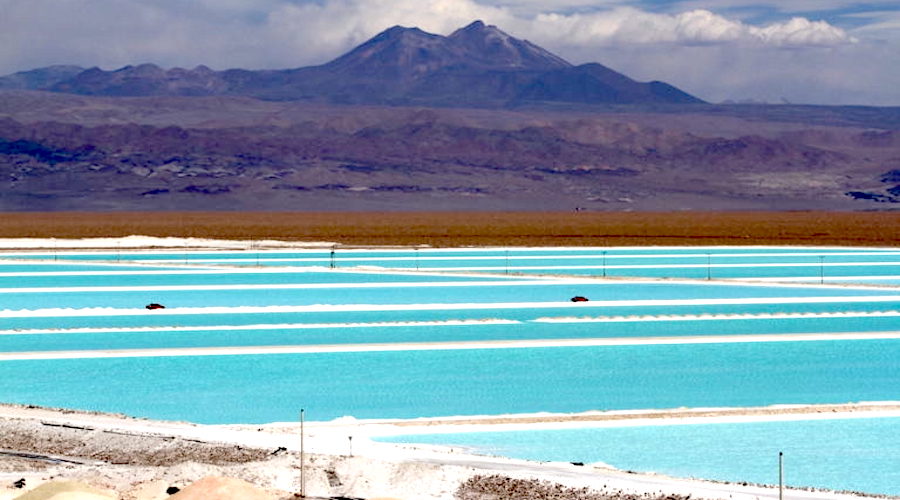
Lithium brines are found in the middle of Chile’s Salar de Atacama and contain the world’s highest known concentrations of lithium and potassium. (Image courtesy of SQM.)
Chilean President Gabriel Boric’s plan to nationalize his country’s immense lithium industry is putting the spotlight on an emerging crop of filtration technologies aimed at revolutionizing how the metal is produced for the electric vehicle industry.

In a national prime time address, Boric said last Thursday a new state-owned company would work to slash the environmental impacts of lithium production by shifting away from evaporation ponds, traditionally used to remove the metal from brine, in favor of direct lithium extraction (DLE).
While neighboring Bolivia, as well as General Motors Co, Rio Tinto Ltd and other companies, have made their own DLE bets, Boric’s move represents the biggest vote of confidence to date in the commercially unproven suite of technologies given plans to deploy it across Chile’s vast lithium reserves, the world’s largest.
“This is the best chance we have at transitioning to a sustainable and developed economy,” said Boric, a leftist 37-year-old elected in late 2021.
DLE technologies are designed to extract the metal from salty brines in Chile’s Atacama Desert and elsewhere in the world using filters, membranes, ceramic beads or other equipment that can typically be housed in a small warehouse.
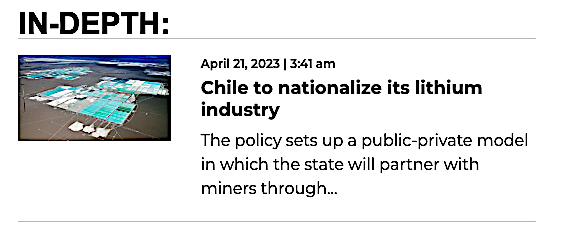
While multiple companies are working to develop competing versions, the broad promise of DLE is a boost to global lithium production with a footprint far smaller than open-pit mines and evaporation ponds often are the size of multiple football fields and unpopular with local communities.
Many DLE technologies use lots of potable water and electricity. None have yet to work independently at commercial scale. If Chile could help one or more DLE technology succeed, it would cement the country’s dominant role in the global lithium and EV industries for decades to come.
“The devil is in the details, but it’s a great opportunity for technological innovation of brine processing, either way,” Chris Berry, an independent lithium industry consultant, said of Boric’s plan.
SQM and Albemarle Corp, Chile’s two existing lithium producers, use evaporation ponds to produce the metal. Both are studying DLE, though neither have deployed it. Livent Corp uses a variation of DLE technology in Argentina alongside evaporation ponds.
“Now that regulatory bodies are forcing the issue, it’s only going to speed up the innovation and commercialization,” said Teague Egan, CEO of privately held EnergyX, which is building a DLE test facility in northern Chile and has a development project with GM.
The goal for Boric and the DLE industry is to extract lithium from brine and reinject what is left back underground, in a closed loop process that does not affect water tables.
“Boric recognizes you can’t just evaporate all the water and wreck the geological structures,” said John Burba, who helped pioneer one DLE technology in the 1970s and is now CEO of International Battery Metals Ltd, which builds portable DLE plants.
Lake Resources NL, Vulcan Energy Resources Ltd, Renault SA and Stellantis NV are also supporting DLE projects.
Lake Resources is working with Bill Gates-backed Lilac Solutions Inc to deploy Lilac’s DLE technology in Argentina. Lilac also plans to install a DLE test facility in Chile in coming weeks, said CEO Dave Snydacker.
“DLE is a great way for Chile to expand production in an environmentally friendly and scalable way,” said Snydacker.
Several prominent short sellers in recent years have alleged that DLE technologies from Lilac and Standard Lithium Ltd do not work, charges the companies have strongly denied.
In Chile, DLE companies see a business opportunity despite the nationalization plans given that Boric’s new state lithium company is expected to need technical support.
“Nationalization or not, they’ll require technology,” said Amanda Sanregret of privately held Summit Nanotech Corp, which earlier this month opened a Santiago office and DLE test facility.
(By Ernest Scheyder; Editing by Richard Chang)

Lithium brines are found in the middle of Chile’s Salar de Atacama and contain the world’s highest known concentrations of lithium and potassium. (Image courtesy of SQM.)
Chilean President Gabriel Boric’s plan to nationalize his country’s immense lithium industry is putting the spotlight on an emerging crop of filtration technologies aimed at revolutionizing how the metal is produced for the electric vehicle industry.

In a national prime time address, Boric said last Thursday a new state-owned company would work to slash the environmental impacts of lithium production by shifting away from evaporation ponds, traditionally used to remove the metal from brine, in favor of direct lithium extraction (DLE).
While neighboring Bolivia, as well as General Motors Co, Rio Tinto Ltd and other companies, have made their own DLE bets, Boric’s move represents the biggest vote of confidence to date in the commercially unproven suite of technologies given plans to deploy it across Chile’s vast lithium reserves, the world’s largest.
“This is the best chance we have at transitioning to a sustainable and developed economy,” said Boric, a leftist 37-year-old elected in late 2021.
DLE technologies are designed to extract the metal from salty brines in Chile’s Atacama Desert and elsewhere in the world using filters, membranes, ceramic beads or other equipment that can typically be housed in a small warehouse.

While multiple companies are working to develop competing versions, the broad promise of DLE is a boost to global lithium production with a footprint far smaller than open-pit mines and evaporation ponds often are the size of multiple football fields and unpopular with local communities.
Many DLE technologies use lots of potable water and electricity. None have yet to work independently at commercial scale. If Chile could help one or more DLE technology succeed, it would cement the country’s dominant role in the global lithium and EV industries for decades to come.
“The devil is in the details, but it’s a great opportunity for technological innovation of brine processing, either way,” Chris Berry, an independent lithium industry consultant, said of Boric’s plan.
SQM and Albemarle Corp, Chile’s two existing lithium producers, use evaporation ponds to produce the metal. Both are studying DLE, though neither have deployed it. Livent Corp uses a variation of DLE technology in Argentina alongside evaporation ponds.
“Now that regulatory bodies are forcing the issue, it’s only going to speed up the innovation and commercialization,” said Teague Egan, CEO of privately held EnergyX, which is building a DLE test facility in northern Chile and has a development project with GM.
The goal for Boric and the DLE industry is to extract lithium from brine and reinject what is left back underground, in a closed loop process that does not affect water tables.
“Boric recognizes you can’t just evaporate all the water and wreck the geological structures,” said John Burba, who helped pioneer one DLE technology in the 1970s and is now CEO of International Battery Metals Ltd, which builds portable DLE plants.
Lake Resources NL, Vulcan Energy Resources Ltd, Renault SA and Stellantis NV are also supporting DLE projects.
Lake Resources is working with Bill Gates-backed Lilac Solutions Inc to deploy Lilac’s DLE technology in Argentina. Lilac also plans to install a DLE test facility in Chile in coming weeks, said CEO Dave Snydacker.
“DLE is a great way for Chile to expand production in an environmentally friendly and scalable way,” said Snydacker.
Several prominent short sellers in recent years have alleged that DLE technologies from Lilac and Standard Lithium Ltd do not work, charges the companies have strongly denied.
In Chile, DLE companies see a business opportunity despite the nationalization plans given that Boric’s new state lithium company is expected to need technical support.
“Nationalization or not, they’ll require technology,” said Amanda Sanregret of privately held Summit Nanotech Corp, which earlier this month opened a Santiago office and DLE test facility.
(By Ernest Scheyder; Editing by Richard Chang)
Lithium developer joins race to produce green fuel in Chile’s arid desert
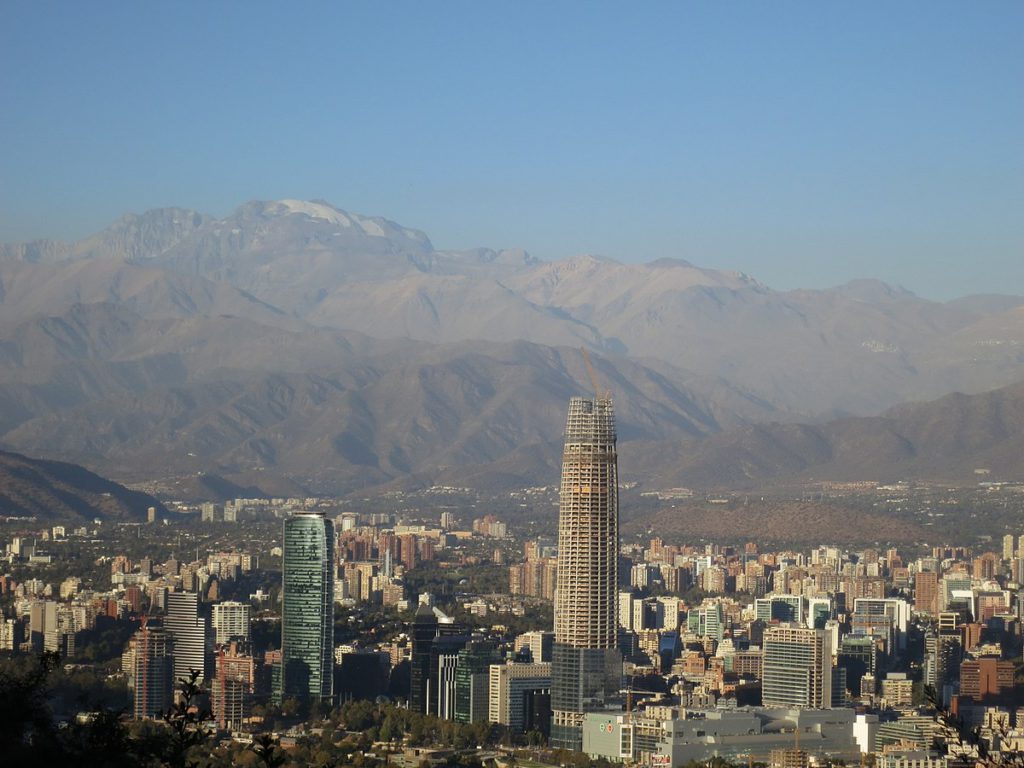
Santiago, Chile. Credit: Wikimedia Commons
A group of US investors is joining the race to produce green fuel from Chile’s vast renewable energy potential, with ambitions of building a $2.5 billion plant in the sun-drenched northern desert.

MAE — which began life as a solar venture backed by a group of investors led by James Calaway, the former chairman of lithium miner Orocobre and current chairman of Nevada-based lithium developer Ioneer — is now in talks with potential off-takers and is preparing to seek environmental permits later this year for a green ammonia plant, chief executive officer Gonzalo Moyano said in an interview.
Chile’s government is encouraging green hydrogen investment to harness the nation’s abundant solar and wind resources and create a new export industry. There are about 50 projects at different stages in the country, according to green hydrogen organization H2, some of them backed by utilities such as Engie, AES Andes, and Enel.
“The industry has a big potential especially within the European and Asian markets, with relevant decarbonization goals, while the geopolitical situation is accelerating demand for green hydrogen and ammonia,” Moyano said.
MAE’s Volta Project in the port city of Mejillones is slated to begin operations in 2027 at an annual rate of 300,000 metric tons, with output set to double in a later stage, he said.
(By Eduardo Thomson and Valentina Fuentes)
Bloomberg News | April 26, 2023 |

Santiago, Chile. Credit: Wikimedia Commons
A group of US investors is joining the race to produce green fuel from Chile’s vast renewable energy potential, with ambitions of building a $2.5 billion plant in the sun-drenched northern desert.

MAE — which began life as a solar venture backed by a group of investors led by James Calaway, the former chairman of lithium miner Orocobre and current chairman of Nevada-based lithium developer Ioneer — is now in talks with potential off-takers and is preparing to seek environmental permits later this year for a green ammonia plant, chief executive officer Gonzalo Moyano said in an interview.
Chile’s government is encouraging green hydrogen investment to harness the nation’s abundant solar and wind resources and create a new export industry. There are about 50 projects at different stages in the country, according to green hydrogen organization H2, some of them backed by utilities such as Engie, AES Andes, and Enel.
“The industry has a big potential especially within the European and Asian markets, with relevant decarbonization goals, while the geopolitical situation is accelerating demand for green hydrogen and ammonia,” Moyano said.
MAE’s Volta Project in the port city of Mejillones is slated to begin operations in 2027 at an annual rate of 300,000 metric tons, with output set to double in a later stage, he said.
(By Eduardo Thomson and Valentina Fuentes)
Albemarle holds talks on lithium nationalization plan
Reuters | April 25, 2023 |
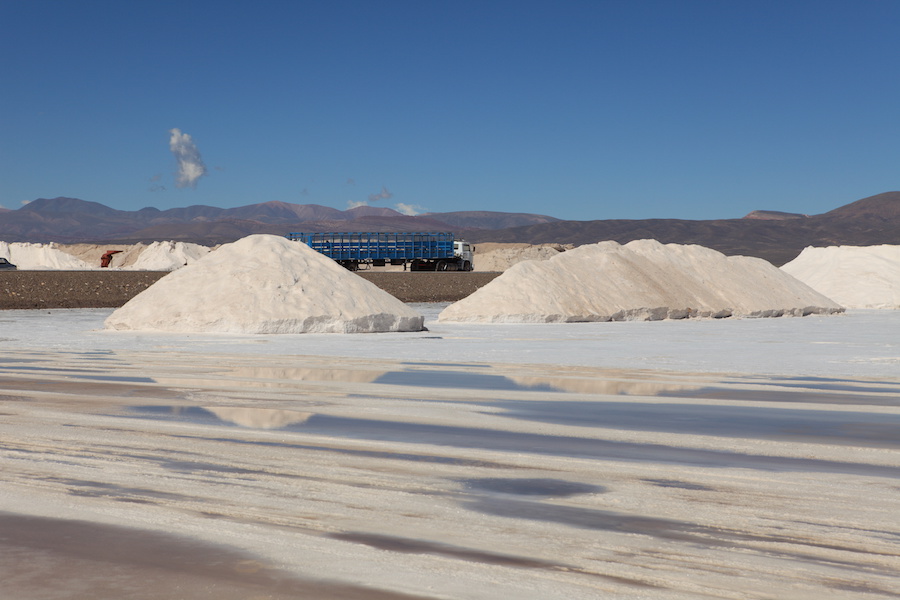
Chile’s Atacama salt flat, home to leading lithium producers Albemarle and SQM, accounts for around one-third the world’s supply. (Stock image)
Chile’s state development office Corfo said on Tuesday it met with US-based miner Albemarle to discuss the South American country’s plan to nationalize the lithium industry.

Chile’s leftist President Gabriel Boric last week announced that control of the country’s vast lithium operations would over time be transferred from Albemarle and SQM to a separate state-owned company.
The move shocked investors and foreign companies and raised concerns about the production and supply of lithium, a metal essential in electric vehicle batteries. Chile has the world’s largest lithium reserves.
Albemarle’s Chile manager, Ignacio Mehech, and Corfo Vice President Jose Miguel Benavente discussed the government’s plan, which focuses primarily on the Atacama salt flat where Albemarle has a contract to operate until 2043, Corfo said in a statement.
Corfo will continue owning mining properties, while mining would be carried out by lease contracts that “gradually incorporate the state” through public-private alliances with a state majority, the statement said.
Benavente said the “public-private association and a possible extension beyond 2043” would be defined at a later date, but added that the agreement should benefit both parties.
In a separate statement released after the meeting, Mehech said Boric’s statement about respecting contracts is an “unequivocal sign to the market that lets us maximize our commitment in Chile.” He added that Albemarle, the world’s largest producer of lithium, wants to grow in Chile and in the Atacama salt flat with new technologies.
“The new era of lithium is in total sync with the lithium strategy the government has outlined,” Mehech said, adding that the company is looking to advance its direct lithium extraction technology, which is a key element of the government’s plan.
Economy Minister Nicolas Grau told Reuters on Monday that the government will start official talks with both lithium operators through state-miner Codelco by the middle of this year and hopes to have an agreement before the end of Boric’s term in 2026.
On Monday, SQM CEO Ricardo Ramos also met with Corfo and said the Chilean lithium company, the world’s second-largest producer of the metal, would require $2 billion to enact the government’s plans. SQM’s contract expires in 2023.
(By Fabian Cambero, Brendan O’Boyle and Alexander Villegas; Editing by Isabel Woodford and Paul Simao)

Chile’s Atacama salt flat, home to leading lithium producers Albemarle and SQM, accounts for around one-third the world’s supply. (Stock image)
Chile’s state development office Corfo said on Tuesday it met with US-based miner Albemarle to discuss the South American country’s plan to nationalize the lithium industry.

Chile’s leftist President Gabriel Boric last week announced that control of the country’s vast lithium operations would over time be transferred from Albemarle and SQM to a separate state-owned company.
The move shocked investors and foreign companies and raised concerns about the production and supply of lithium, a metal essential in electric vehicle batteries. Chile has the world’s largest lithium reserves.
Albemarle’s Chile manager, Ignacio Mehech, and Corfo Vice President Jose Miguel Benavente discussed the government’s plan, which focuses primarily on the Atacama salt flat where Albemarle has a contract to operate until 2043, Corfo said in a statement.
Corfo will continue owning mining properties, while mining would be carried out by lease contracts that “gradually incorporate the state” through public-private alliances with a state majority, the statement said.
Benavente said the “public-private association and a possible extension beyond 2043” would be defined at a later date, but added that the agreement should benefit both parties.
In a separate statement released after the meeting, Mehech said Boric’s statement about respecting contracts is an “unequivocal sign to the market that lets us maximize our commitment in Chile.” He added that Albemarle, the world’s largest producer of lithium, wants to grow in Chile and in the Atacama salt flat with new technologies.
“The new era of lithium is in total sync with the lithium strategy the government has outlined,” Mehech said, adding that the company is looking to advance its direct lithium extraction technology, which is a key element of the government’s plan.
Economy Minister Nicolas Grau told Reuters on Monday that the government will start official talks with both lithium operators through state-miner Codelco by the middle of this year and hopes to have an agreement before the end of Boric’s term in 2026.
On Monday, SQM CEO Ricardo Ramos also met with Corfo and said the Chilean lithium company, the world’s second-largest producer of the metal, would require $2 billion to enact the government’s plans. SQM’s contract expires in 2023.
(By Fabian Cambero, Brendan O’Boyle and Alexander Villegas; Editing by Isabel Woodford and Paul Simao)
SQM expects to start talks on lithium with government soon
Reuters | April 26, 2023
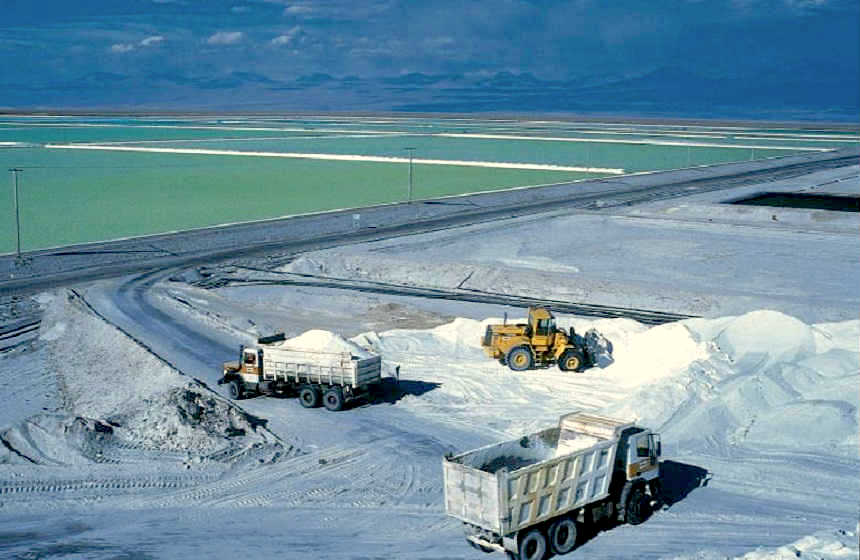
Image courtesy of SQM.
Chilean lithium miner SQM expects to start talks about lithium with Chilean authorities soon, its Chairman Gonzalo Guerrero said in a letter to shareholders Wednesday.

The South American nation announced last week a plan for a state-led model for the lithium industry where the country would have majority control over new lithium developments in partnerships with the private sector.

“SQM’s experience has allowed Chile to be a world leader in lithium,” Guerrero said in the letter, adding that the company “hopes to soon start conversation with authorities, with the goal of creating value for all involved groups.”
Guerrero also said the company’s 2023-2025 investment plan totals $3.4 billion, including maintenance, of which $1.4 billion was aimed at increasing lithium production in Chile.
The company seeks to increase current lithium carbonate capacity to 210,000 tonnes from 180,000 by the end of 2024 and lithium hydroxide capacity from 30,000 to 100,000 tonnes by 2025.
The plan also has around $450 million for a join venture project in Australia, but “not all in lithium.” Some of the funding will go to increasing plant capacity for iodine, nitrates and others.
On Monday, Economy Minister Nicolas Grau told Reuters that negotiations to increase state control of the Salar de Atacama would begin by mid-year.
The negotiation process will be carried out through the state-owned Codelco, the world’s largest copper producer.
SQM general manager, Ricardo Ramos, met this week with state development office Corfo to discuss the government’s lithium plan.
(By Fabian Cambero and Valentine Hilaire; Editing by Isabel Woodford and Emelia Sithole-Matarise)
Reuters | April 26, 2023

Image courtesy of SQM.
Chilean lithium miner SQM expects to start talks about lithium with Chilean authorities soon, its Chairman Gonzalo Guerrero said in a letter to shareholders Wednesday.

The South American nation announced last week a plan for a state-led model for the lithium industry where the country would have majority control over new lithium developments in partnerships with the private sector.

“SQM’s experience has allowed Chile to be a world leader in lithium,” Guerrero said in the letter, adding that the company “hopes to soon start conversation with authorities, with the goal of creating value for all involved groups.”
Guerrero also said the company’s 2023-2025 investment plan totals $3.4 billion, including maintenance, of which $1.4 billion was aimed at increasing lithium production in Chile.
The company seeks to increase current lithium carbonate capacity to 210,000 tonnes from 180,000 by the end of 2024 and lithium hydroxide capacity from 30,000 to 100,000 tonnes by 2025.
The plan also has around $450 million for a join venture project in Australia, but “not all in lithium.” Some of the funding will go to increasing plant capacity for iodine, nitrates and others.
On Monday, Economy Minister Nicolas Grau told Reuters that negotiations to increase state control of the Salar de Atacama would begin by mid-year.
The negotiation process will be carried out through the state-owned Codelco, the world’s largest copper producer.
SQM general manager, Ricardo Ramos, met this week with state development office Corfo to discuss the government’s lithium plan.
(By Fabian Cambero and Valentine Hilaire; Editing by Isabel Woodford and Emelia Sithole-Matarise)
Bloomberg News | April 25, 2023 |
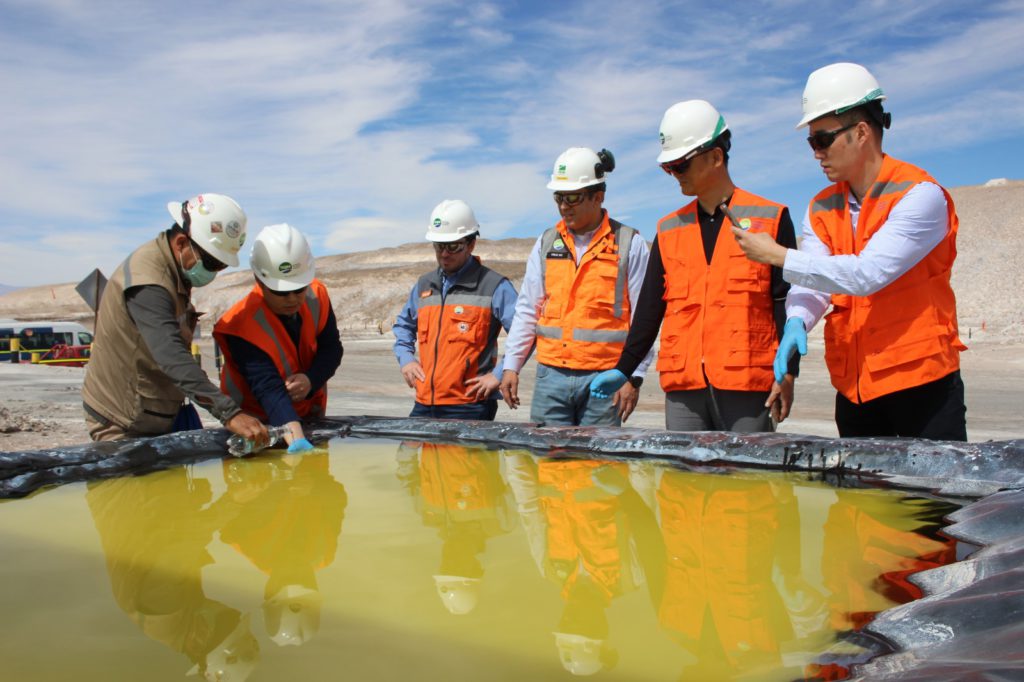
Image from SQM.
SQM, the world’s No. 2 lithium producer, expects to reach an agreement to continue producing the battery metal under the Chilean government’s new public-private model for the industry.

The company is “convinced” that its technology and experience “will make it possible to reach reasonable agreements in the interest of the Chilean state as well as our diverse shareholders,” it said in a statement Monday after executives met with officials at state development agency Corfo.
SQM, the fertilizer-turned-lithium giant, runs the planet’s biggest and most profitable brine operation in Chile’s northern desert with a contract that expires in 2030. Under the government’s new policy, SQM can either keep full control of the operation for the rest of the contract and then risk losing it or let the state take a majority stake with the understanding it could keep operating longer. Copper producer Codelco will represent the state in negotiations with SQM.
SQM has budgeted more than $2 billion on technologies that enable it to eliminate the use of underground fresh water, make its brine evaporation process more efficient and introduce direct extraction. That would bring it in line with sustainability practices laid out in the government’s new strategy, it said in the statement.
Shares in Soc. Quimica & Minera de Chile SA, as the company is known formally, fell by a record on Friday after the new development model was announced, before regaining some ground Monday. The stock was down 1.7% at 9:34am in New York on Tuesday.
(By James Attwood)
No comments:
Post a Comment